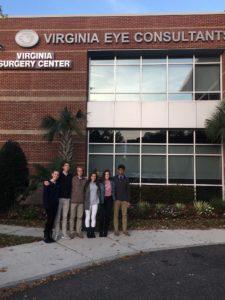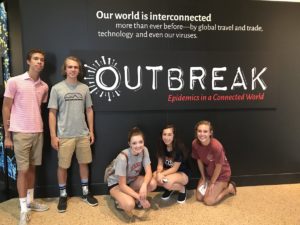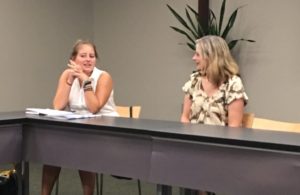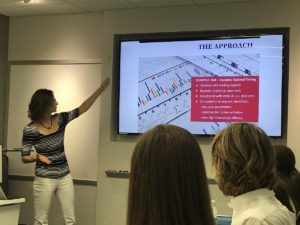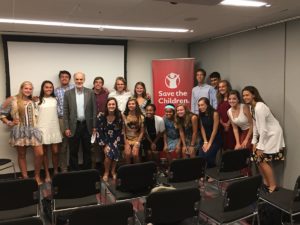GHFs Visit Chemonics, the State Department, CARE, and Mary’s Center by Julia Duarte (2020)
On Thursday, I woke up to Madeleine calling my name at 7:00. After a few more minutes of comfortable sleep, I forced myself to get out of bed and I proceeded to get ready. Thoughts reminiscing about the inspirational speakers of the previous day and preparing myself for the full day ahead ran through my head as I brushed my teeth. Once we were all ready, Madeleine, Anaiya, and I grabbed our bags and went downstairs for breakfast.
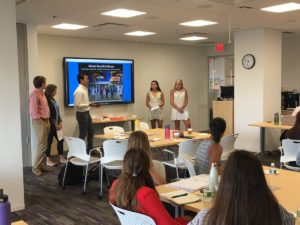
GHF 19s present about our program and work in Belize to a panel at Chemonics.
After we were all fueled by waffles and coffee, we jogged on to the bus at 8:10, a time which was a little earlier than planned in the event that we met some D.C. traffic. Our cautiousness was awarded by an extra 20 minute break outside in the nice weather. When 8:50 came around, we crossed the street to the large building that houses the private international development company, Chemonics. We made our way up an elevator to a sunlit room where we would be both presenting to a panel of experts (this was the only company to ask us to do this) and listening to the presentation of the panelists. I grabbed a coffee (yes, for the second time) and sat down with my cohort at a table and directed my attention to the ‘19s, who would be presenting our mission and previous work in the field. Watching the seniors carry themselves with poise and listening to them speak with clarity and a sort of passion made me only hope that someday I could be as confident of a public speaker as they were. I was definitely proud to have them representing this program. Once the presentation concluded, I saw the amazed gazes of the three women sitting in front of us. Ms. Doris Youngs, Ms. Ashley Greve, and Ms. Megan Nelson directed some questions our way, which excited me to see three experts interested in the work of a handful of teenagers.
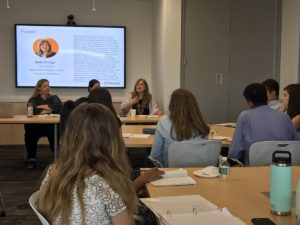
Panel of experts at Chemonics!
After they talked about their own work within and outside of Chemonics, we began to slowly pour out our thoughts and questions to them. With each question, the three spoke with more and more passion and displayed their knowledge and experience in front of us. I was so overwhelmed (in a good way) by so much information that two hours flew by too quickly. We said hasty goodbyes and headed off to lunch. I ate a filling salad at Panera while getting to know Leila, a newbie to this program.
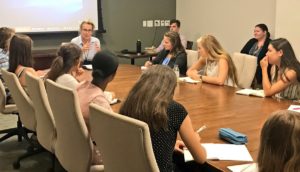
Ambassador Birx welcomes GHFs to the State Department
At 12:50, we all convened in front of the US Department of State building. Andrew and Kara, the leaders of the day, briefed us on PEPFAR right before two men came outside to escort us through security and to the elevators. At the conference room, we got the chance to meet and speak to Ambassador Birx, Mr. Jason Bowman, Ms. Neeta Bhandari and others. We learned about the United States’ involvement in the history of the HIV/AIDS epidemic, the application of maps and geographic information to outbreaks and disease, public-private partnerships, and more. An hour and a half did not offer sufficient time for us to hear what the experts had to say and to ask questions. At the end, we thanked everyone who spoke to us, were ushered downstairs, and quickly hopped on the bus so that we could be taken to our next stop. At 3:00 we were dropped off at CARE, an international humanitarian organization. We met with Ms. Kristin Wells, who does advocacy work at CARE (fun fact: the first care packages were created here). CARE has certainly evolved from physical care packages to “conceptual care packages”, as Ms. Wells stated. Now, they are offering emergency relief aid, women’s rights advocacy, and long-term development programs around the world.
Next, we arrived at the community health center, Mary’s Center (which was founded in a basement!) and we listened to Ms. Bethlehem Muleta and Ms. Selene Tituana speak about the mission of Mary’s Center and community health education research that has been conducted. After we asked a few questions, we split into two groups and we were taken on a tour around the facility. Seeing many components, such has the medical sector, dental sector, and education facilities, really opened my eyes to all the good that they offer to people of all ages and backgrounds. We left the building (not before taking a few pictures.. Which reminds me, please check out our twitter! @NA_Fellows) and made our regular dash onto the bus. Before we knew it, we were at the hotel and running into the lobby. We were given ample time to change out from our formal outfits and relax before heading downstairs to head to Shake Shack (shoutout to Ells’ persistent pleas for burgers). At Shake Shack, I sat with Courtney, Connor, and Sahib and laughed at nothing and everything. That, combined with a good burger and shake, was a perfect conclusion to a perfect day.
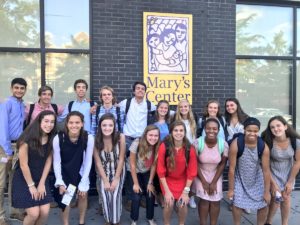
GHFs pose in front of Mary’s Center.
I’m not done yet (so sorry)!! In the evening we all met up in Ms. Nas’ room, listened to each others’ roses and thorns, got a spiel of tomorrow’s schedule from Madeleine, and read Global Health Now! articles to prepare for tomorrow’s visit.
At night, we were in Connor and Sahib’s room after the meeting and talked about what you expect teenagers to talk about: gossip, school, vines, etc. But looking around at the different but the most familiar faces and knowing that we are all connected by a common interest, that we all experienced the once unimaginable, and that we were in for more adventures, jokes, teasing, learning, thinking, laughs, and growing up with one another, I felt an overwhelming feeling of joy that this experience permanently intertwines us into each others’ lives. I reflected on this in my bedroom and before I knew it, my 6:00 alarm was blaring into my ear signalling the start of a new, exciting day.
